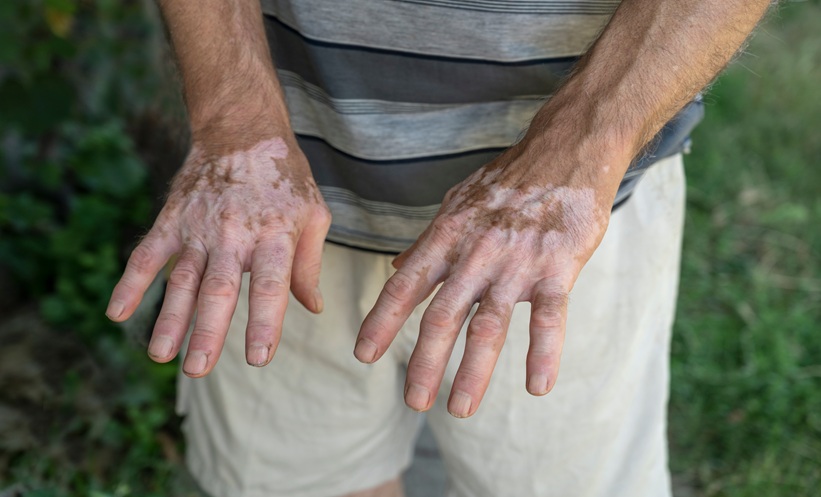Author: Darcy Richards, EMJ, London, UK
Citation: Dermatol AMJ. 2024;1[1]:27-30. https://doi.org/10.33590/dermatolamj/BSWH2237.
![]()
NOVEL THERAPEUTICS AND TRIAL DATA
Bruce Strober, Yale University School of Medicine, New Haven, Connecticut, USA, opened the session by highlighting the recent U.S. approval of an IL-17A and IL-17F monoclonal antibody, bimekizumab, capable of blocking all three types of IL-17A and IL-17F homo- and heterodimers. Strober emphasized that treatment efficacy for psoriasis and psoriatic arthritis is enhanced by targeting both IL-17A and IL-17F. Noting this, Strober discussed the efficacy of bimekizumab in treating moderate-to-severe psoriasis. Presenting data from the BE READY trial,1 he showed that treatment with bimekizumab led to 90.8% of patients achieving a Psoriasis Area and Severity Index (PASI) score of 90 within 16 weeks of treatment, compared to just 1.2% for those given placebo. Further to this, he commented that evidence has shown IL-17A/IL-17F blockade to be fruitful in treating scalp psoriasis, with up to 85.0–88.0% of patients achieving scalp clearance.
Of note, the trial highlighted the increased risk of Candida infections in these patients as a challenge associated with IL-17F blockade.1 Strober commented that compared to traditional IL-17 inhibitors, where 1.0–3.0% will experience mucosal candidiasis, the rates are 10.0–15.0% when treated with IL-17A/IL-17F monoclonal antibodies. However, he noted that fungal infection incidence drops after the first year when looking at pooled data from five Phase III trials. This could be due to depletion of susceptible patients over time.
Spotlighting his real-world experience, Strober explained that in the approximately 30 patients he has initiated on bimekizumab, the rate of Candida infection has not been as high as that seen in the literature. He also emphasized the need to assess patients for a history of inflammatory bowel disease, in which case the drug is contraindicated.
The speaker also explored retention of therapeutic efficacy, touching on dosing strategies and their relation to this. Looking at data from a post hoc analysis of five Phase III/IIIb trials, he expressed that for those who achieve PASI 90 by Week 16 of treatment, there is an 82.0% likelihood of retaining this response over 2 years.
Strober further discussed that spesolimab, an anti-IL-36 receptor antibody, has been approved to treat flares of generalized pustular psoriasis as a single intravenous dose, and highlighted the Effisayil 1 study,2 which looked at the Generalized Pustular Psoriasis Physician Global Assessment (GPPGA) pustulation subscore 1 week after spesolimab injection. The study found that 54.0% of patients treated with spesolimab had a GPPGA pustulation subscore of 0 at Week 1, irrespective of disease severity at baseline. He further spoke on Effisayil 2,3 which looked at the use of subcutaneous spesolimab in prevention of flares, noting that this could potentially be approved in the USA in the near future. The study reviewed three different doses (high dose, medium dose, and low dose) and a placebo given regularly over 48 weeks in high-risk patients with generalized pustular psoriasis.3 In the high-dose group, no flares occurred after Week 4, and there was an 84.0% risk reduction for developing a flare.3 Those in the medium-dose and low-dose groups achieved an intermediate response.
The presentation also discussed a Phase III, unapproved, investigational drug, TAK-279, which is a tyrosine kinase 2 (TYK2) inhibitor. Interestingly, Phase IIb data for use of TAK-279 in moderate-to-severe psoriasis showed that at Week 12, approximately 67.0% achieved PASI 75 when given at higher doses.4 Strober noted that deucravacitinib, another TYK2 inhibitor approved for use in psoriasis approximately 18 months ago, achieved a PASI 75 of approximately 45.0–50.0% at Week 12 and 58.7% at Week 16, which increased to 69.0% by 6 months.5 These early results indicate that TAK-279 could be more effective than deucravacitinib; however, there is a need to see if these results are replicated in Phase III studies. Acne and acneiform dermatitis, which occur with almost all TYK2 inhibitors, were noted as the adverse events associated with TAK-279 treatment.4
Strober also expressed excitement when discussing an unapproved oral peptide therapy (JNJ-77242113). This novel IL-23 receptor antagonist blocks the IL-23 receptor directly, which is a novel mechanism of action. Strober explained that JNJ-77242113 has gastrointestinal stability and can induce systemic IL-23 receptor blockade with only 1.0% bioavailability when taken orally. When looking at dosing and PASI 75, a dose response curve was seen. Nearly 80.0% of those who received the highest dose achieved PASI 75 by Week 16, compared to approximately 67.0% for TAK-279 at Week 12.6 Strober also highlighted that in terms of PASI 90 and PASI 100, JNJ-77242113 is comparable to some biologic therapies, at 59.5% and 40.5%, respectively.6 Regarding safety, Strober explained that through Week 16, the safety is what would be expected from an IL-23 inhibitor, with a possible increase in upper respiratory tract infections at the higher doses.6 Phase III results are awaited.
VISIBLE,7 a novel study assessing an IL-23 inhibitor, guselkumab, in treating scalp psoriasis across all skin tones, revealed that a scalp-specific Investigator’s Global Assessment (ss-IGA) score of 0/1 (no or very mild disease) and Psoriasis Scalp Severity Index (PSSI) 90 scores were achieved in significantly more patients receiving guselkumab than placebo. There was also a greater mean change from baseline Psoriasis Symptoms and Signs Diary (PSSD) by Week 16 in patients treated with guselkumab, compared to placebo.7 Additionally, guselkumab improved patient-reported impact of skin discoloration at Week 16 compared to placebo, as shown by a reduction in Skin Discoloration Impact Evaluation Questionnaire (SDIEQ) scores.7 This is a novel outcome measure for skin studies.
COULD EARLY TREATMENT IMPACT PSORIASIS OUTCOMES?
Following this, Richard Langley, Dalhousie University, Halifax, Nova Scotia, Canada, presented on the early treatment of psoriasis. Stressing its importance, Langley stated: “We should be looking at our patients who have significant psoriasis […] and trying to get them under effective control, however we can, as soon as possible.”
He noted that different guidelines and strategies for treating psoriasis exist in different countries, and emphasized the aspirational nature of his presentation, as this is important in advocating for patients.
Langley explored several key questions when discussing the value of early treatment in psoriasis, including whether early intervention can impact comorbidities, prevent disease progression, or induce remission. When considering comorbidities, he highlighted an example case of a 54-year-old male with psoriasis. The existing comorbidities included smoking, elevated BMI, elevated cholesterol, high blood pressure, and borderline diabetes. Langley discussed how this patient’s risk for a myocardial infarction would be 32.0%, but stressed that this calculation does not account for the psoriasis diagnosis. Alongside risk factor modification, treating the psoriasis could also help reduce this cardiovascular risk. Langley noted the importance of inflammation and that treating it could potentially decrease the mortality associated with psoriasis. He spotlighted striking data from the SOLAR registry, which looked at 12,000 patient years over a 7-year follow-up period. At baseline, many individuals had risk factors; however, a significant reduction in mortality was seen for those treated with biologics and methotrexate. Anecdotally, he commented that this has changed the way he counsels patients about controlling their inflammation. Considering this, Langley explained that if patients have concerns about the side effects of treatments, clinicians need to discuss weighing the risk factors with the risk of not treating, and the potential impact this may have on both an individual’s quality and quantity of life.
Psoriatic arthritis is another major comorbidity of psoriasis. Langley noted that a number of studies have hinted at improvement of prevention following treatment with biologics. He highlighted the prospective PAMPA trial8 for prevention of psoriatic arthritis, utilizing ultrasound enrichment to determine if treatment prevents psoriatic arthritis. Langley commented that these types of study are needed, and that he is optimistic about the future.
The other area in which early treatment could impact psoriasis is disease progression and remission. Langley considered treating at an earlier stage, highlighting an individual case in which a 19-year-old patient with a 1-year history of psoriasis was given a single dose of rizankizumab, did not attend recall, yet remained PASI 100 for 7 years. He also highlighted drug withdrawal studies that found that half of patients did not have disease 8 months after drug withdrawal, which is longer than the drug half-life itself. He postulated on why some patients remain clear when off therapy and if there is a difference in treating early, exploring the concept of the molecular scar. Research has shown that tissue resident memory CD8+ T cells remain present in the skin and could cause disease recurrence. Treatment with secukinumab has shown normalization of molecular scar transcriptomes in moderate-to-severe psoriasis. This posed the question of whether early use of systemics could lead to prolonged remission. Exploring the ECLIPSE study,9 he highlighted that data have shown CD8+ T cells are reduced to a greater extent by guselkumab than secukinumab, and that this may help explain the durability of IL-23 inhibition.
Langley spoke on a study looking at molecular transcriptomes in patients with new-onset and chronic psoriasis. Whilst in both cohorts, reversion of skin transcriptomes to that of a non-lesional state occurred following 52 weeks of secukinumab treatment, normalization of these transcriptomes occurred more quickly in patients with new-onset disease, compared to those with chronic disease at 16 weeks versus 52 weeks, respectively.
Langley also discussed the GUIDE study, which looked at retreatment in super-responders following guselkumab withdrawal and a long treatment-free period. Treatment free periods were shown to be longer for those with ultra-short disease duration (disease duration <15 months) than those with intermediate-short disease duration and long disease duration.
Langley concluded by stressing that early treatment can lead to higher response rates and increased likelihood of achieving remission; could contribute to disease prevention and comorbidity progression; and may result in enhanced life quality and quantity for patients.
CONCLUSION
Overall, Strober and Langley highlighted a buzz around the potential for treating psoriasis, with the development of multiple new therapeutics being tested at different trial/investigational phases, and promising research highlighting the possible impact that early therapeutic intervention could have on patient quality and quantity of life.







